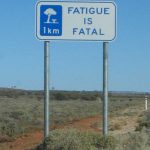I’m kicking of Fatigue Week today, where I’ll be dealing with the issues surrounding lack of sleep. As you all know, trauma professionals are expected to perform even if they have not had adequate sleep. This can occur with certain shift schedules, long periods of work, or due to call schedules and duration of call. What do we really know about the effects of sleep deprivation on us?
Today, we’ll talk about decision making. Neuroscientists at Duke looked at how we approach risky decisions when we are sleep deprived. A total of 29 adults (average age 22) were studied. They were not allowed to use tobacco, alcohol and most medications prior to sleep deprivation, which lasted for 24 hours. They were given a risky decision making task (a controlled form of gambling), and two other tests while in a functional MRI unit to watch areas of brain activation.
The researchers found that, when well rested, the subjects had a bias toward avoiding loss in the gambling test. After a single night of sleep deprivation, this shifted to pursuing gain. The MRI also showed an increased activity in the reward anticipation parts of the brain. Overall decreased vigilance was noted, but this did not correlate with the shift away from risk avoidance.
Bottom line: Sleep deprivation appears to create an optimism bias. Fatigued individuals act like positive outcomes are more likely and negative consequences are less likely. One of the most common and important things that trauma professionals do is to make decisions that may affect patient outcome (e.g. choose a destination hospital, intubate, order and interpret a test, move to the operating room, choose a specific operative procedure). We all have a set of thresholds that help us come to the “right” decision based on many variables. It appears that a single night of sleep deprivation has the potential to skew those thresholds, potentially in directions that may not benefit the patient.
Reference: Sleep deprivation biases the neural mechanisms underlying economic preferences. J Neuroscience 31(10):3712-3718, March 9, 2011.


